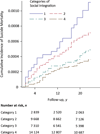Social integration and suicide mortality among men: 24-year cohort study of U.S. health professionals
- PMID: 25023247
- PMCID: PMC4137390
- DOI: 10.7326/M13-1291
Social integration and suicide mortality among men: 24-year cohort study of U.S. health professionals
Abstract
Background: Suicide is a major public health problem. Current thinking about suicide emphasizes the study of psychiatric, psychological, or biological determinants. Previous work in this area has largely relied on surrogate outcomes or samples enriched for psychiatric morbidity.
Objective: To evaluate the relationship between social integration and suicide mortality.
Design: Prospective cohort study initiated in 1988.
Setting: United States.
Participants: 34,901 men aged 40 to 75 years.
Measurements: Social integration was measured with a 7-item index that included marital status, social network size, frequency of contact, religious participation, and participation in other social groups. Vital status of study participants was ascertained through 1 February 2012. The primary outcome of interest was suicide mortality, defined as deaths classified with codes E950 to E959 from the International Classification of Diseases, Ninth Revision.
Results: Over 708,945 person-years of follow-up, there were 147 suicides. The incidence of suicide decreased with increasing social integration. In a multivariable Cox proportional hazards regression model, the relative hazard of suicide was lowest among participants in the highest (adjusted hazard ratio [AHR], 0.41 [95% CI, 0.24 to 0.69]) and second-highest (AHR, 0.52 [CI, 0.30 to 0.91]) categories of social integration. Three components (marital status, social network size, and religious service attendance) showed the strongest protective associations. Social integration was also inversely associated with all-cause and cardiovascular-related mortality, but accounting for competing causes of death did not substantively alter the findings.
Limitations: The study lacked information on participants' mental well-being. Some suicides could have been misclassified as accidental deaths.
Conclusion: Men who were socially well-integrated had a more than 2-fold reduced risk for suicide over 24 years of follow-up.
Primary funding source: National Institutes of Health and Robert Wood Johnson Foundation.
Conflict of interest statement
Disclosures: Authors have disclosed no conflicts of interest. Forms can be viewed at
Figures
Comment in
-
Approaching suicide as a public health issue.Ann Intern Med. 2014 Jul 15;161(2):151-2. doi: 10.7326/M14-0914. Ann Intern Med. 2014. PMID: 25023253 No abstract available.
Summary for patients in
-
Summaries for patients. Social integration and suicide mortality among men.Ann Intern Med. 2014 Jul 15;161(2). doi: 10.7326/P14-9022. Ann Intern Med. 2014. PMID: 25023261 No abstract available.
Similar articles
-
Association Between Social Integration and Suicide Among Women in the United States.JAMA Psychiatry. 2015 Oct;72(10):987-993. doi: 10.1001/jamapsychiatry.2015.1002. JAMA Psychiatry. 2015. PMID: 26222043 Free PMC article.
-
Religious Service Attendance and Deaths Related to Drugs, Alcohol, and Suicide Among US Health Care Professionals.JAMA Psychiatry. 2020 Jul 1;77(7):737-744. doi: 10.1001/jamapsychiatry.2020.0175. JAMA Psychiatry. 2020. PMID: 32374360 Free PMC article.
-
Association Between Religious Service Attendance and Lower Suicide Rates Among US Women.JAMA Psychiatry. 2016 Aug 1;73(8):845-51. doi: 10.1001/jamapsychiatry.2016.1243. JAMA Psychiatry. 2016. PMID: 27367927 Free PMC article.
-
Association of marital status with the incidence of suicide: a population-based Cohort Study in Japan (Miyagi cohort study).J Affect Disord. 2013 Sep 25;150(3):879-85. doi: 10.1016/j.jad.2013.05.006. Epub 2013 Jul 4. J Affect Disord. 2013. PMID: 23830860
-
Risk factors associated with suicide in current and former US military personnel.JAMA. 2013 Aug 7;310(5):496-506. doi: 10.1001/jama.2013.65164. JAMA. 2013. PMID: 23925620
Cited by
-
A Pilot Randomized Trial of Engage Psychotherapy to Increase Social Connection and Reduce Suicide Risk in Later Life.Am J Geriatr Psychiatry. 2021 Aug;29(8):789-800. doi: 10.1016/j.jagp.2021.03.009. Epub 2021 Apr 1. Am J Geriatr Psychiatry. 2021. PMID: 33952416 Free PMC article. Clinical Trial.
-
Accurate Diagnosis of Suicide Ideation/Behavior Using Robust Ensemble Machine Learning: A University Student Population in the Middle East and North Africa (MENA) Region.Diagnostics (Basel). 2020 Nov 16;10(11):956. doi: 10.3390/diagnostics10110956. Diagnostics (Basel). 2020. PMID: 33207776 Free PMC article.
-
Assessing the Determinants of the Wish to Die among the Elderly Population in Ghana.Geriatrics (Basel). 2021 Mar 23;6(1):32. doi: 10.3390/geriatrics6010032. Geriatrics (Basel). 2021. PMID: 33807000 Free PMC article.
-
Anxiety, Depression, and Colorectal Cancer Survival: Results from Two Prospective Cohorts.J Clin Med. 2020 Sep 30;9(10):3174. doi: 10.3390/jcm9103174. J Clin Med. 2020. PMID: 33007946 Free PMC article.
-
Psychosocial characteristics as potential predictors of suicide in adults: an overview of the evidence with new results from prospective cohort studies.Transl Psychiatry. 2018 Jan 22;8(1):22. doi: 10.1038/s41398-017-0072-8. Transl Psychiatry. 2018. PMID: 29353878 Free PMC article. Review.
References
-
- Heron M. Deaths: leading causes for 2008. Natl Vital Stat Rep. 2012;60:1–94. [PMID: 22827019] - PubMed
-
- Corso PS, Mercy JA, Simon TR, Finkelstein EA, Miller TR. Medical costs and productivity losses due to interpersonal and self-directed violence in the United States. Am J Prev Med. 2007;32:474–482. [PMID: 17533062] - PubMed
Publication types
MeSH terms
Grants and funding
LinkOut - more resources
Full Text Sources
Other Literature Sources
Medical

